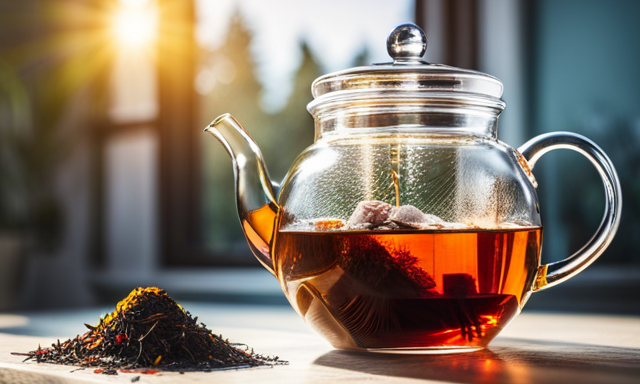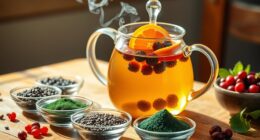I have always been fascinated by the rich history and diverse origins of different types of tea. One particular tea that has captured my attention is rooibos tea. Did you know that rooibos tea is grown exclusively in the Cederberg region of South Africa? This unique tea, also known as red bush tea, has been cultivated by the indigenous people of the area for centuries.
As I delved deeper into the world of rooibos tea, I discovered the meticulous process involved in its cultivation and production. From the careful planting and nurturing of the rooibos plants to the meticulous processing of the leaves, every step is carried out with precision. The result is a tea that boasts a distinct flavor profile and a plethora of health benefits.
Join me on a journey to explore the origins of rooibos tea, the different varieties available, and its growing popularity around the world. Let’s uncover the secrets and delights of this versatile beverage together.
Key Takeaways
- Rooibos tea is grown exclusively in the Cederberg region of South Africa.
- The cultivation techniques of rooibos tea have been passed down through generations and are often practiced using sustainable and organic farming methods.
- The leaves of the Aspalathus linearis plant are carefully selected and harvested by hand, with skilled workers choosing mature leaves.
- The fermentation process of rooibos tea enhances its flavor and color, releases antioxidants and polyphenols, and reduces levels of tannins, resulting in a less bitter taste.
The Origin of Rooibos Tea
Rooibos tea, with its distinct flavor and health benefits, originates from the South African region. This unique herbal tea is made from the leaves of the Aspalathus linearis plant, which is native to the Cederberg Mountains in the Western Cape province of South Africa.
The cultivation techniques for rooibos tea have been passed down through generations, and the historical significance of this beverage in South African culture cannot be overstated. The local Khoisan people were the first to discover the extraordinary properties of rooibos tea and used it for its medicinal benefits.
Today, rooibos tea is grown in the Cederberg region using sustainable farming methods that protect the natural environment. Moving on to cultivating rooibos tea, let’s explore the process in more detail.
Cultivating Rooibos Tea
When it comes to cultivating Rooibos tea, there are specific planting and harvesting methods that are employed. The tea is typically grown from seeds, which are sown in specially prepared beds.
Once the plants reach a certain height, they are carefully harvested by hand, ensuring that only the finest leaves are collected. Additionally, organic farming practices are often employed in the cultivation of Rooibos tea, ensuring that no harmful chemicals or pesticides are used, resulting in a natural and high-quality product.
Planting and Harvesting Methods
The farmers use traditional methods to plant and harvest rooibos tea, creating a connection to the rich history of this delicious beverage. These planting techniques have been passed down through generations, ensuring the highest quality of tea leaves.
-
Careful selection of seeds: Farmers meticulously choose the best rooibos seeds to ensure healthy and robust plants.
-
Optimal planting conditions: The seeds are planted in well-drained soil, with just the right amount of sunlight and water, allowing the plants to thrive.
-
Hand harvesting: The harvesting process is done by hand, with skilled workers carefully selecting the mature leaves for optimum flavor and quality.
These methods not only preserve the authenticity of rooibos tea but also contribute to its unique taste and aroma. Moving forward, let’s explore the organic farming practices employed in cultivating this exceptional tea.
Organic Farming Practices
To truly experience the full flavor and health benefits of this exceptional beverage, you’ll want to learn about the organic farming practices used in cultivating it.
Organic farming benefits both the environment and the quality of the tea. Rooibos tea is often grown using sustainable agriculture practices, which means that it is cultivated without the use of synthetic pesticides, fertilizers, or genetically modified organisms. This ensures that the tea is free from harmful chemicals and retains its natural flavors and nutrients.
Organic farming also promotes soil health and biodiversity, as it encourages the use of natural fertilizers and the preservation of native vegetation. By supporting organic farming practices, we can enjoy a cup of rooibos tea that is not only delicious but also good for the planet.
Now, let’s dive into the fascinating process of processing rooibos leaves.
Processing Rooibos Leaves
When processing Rooibos leaves, there are three key steps involved: fermentation, drying, and grinding.
During the fermentation process, the leaves are bruised and left to oxidize, which enhances the tea’s flavor and color.
After fermentation, the leaves are spread out to dry under the sun, allowing them to lose moisture and become ready for consumption.
Finally, the dried leaves are carefully ground into fine particles, resulting in the distinctive rooibos tea that we all know and love.
Fermentation Process
Imagine sipping on a refreshing cup of rooibos tea, knowing that its distinct flavor comes from the carefully controlled fermentation process. Fermentation techniques play a crucial role in enhancing the taste and aroma of rooibos tea.
During fermentation, the tea leaves are bruised and moistened, allowing natural oxidation to occur. This process gives rooibos tea its characteristic reddish-brown color and enhances its earthy, slightly sweet flavor. Additionally, fermentation contributes to the release of antioxidants and polyphenols, which are known for their health benefits. The fermentation process also helps to reduce the levels of tannins, making rooibos tea less bitter compared to other types of tea.
After fermentation, the leaves are ready for the next step: drying and grinding, which further enhances the flavors and ensures optimal quality.
Drying and Grinding
After the fermentation process, the next step in the production of rooibos tea is drying and grinding. These two steps are crucial in bringing out the distinct flavors and characteristics of the tea.
Various drying techniques are employed, including sun drying, which allows the leaves to naturally dry under the sun’s heat, and artificial drying, which involves using specialized machinery to dry the leaves quickly.
Grinding methods also play a significant role in the final product. The leaves are finely ground to create a smooth and consistent texture, ensuring that the tea brews properly and releases its full flavor.
By carefully controlling the drying and grinding processes, tea producers can maintain the high quality and exceptional taste that rooibos tea is known for.
Now, let’s delve into the numerous health benefits of rooibos tea.
Health Benefits of Rooibos Tea
Rooibos tea offers a range of health benefits due to its antioxidant properties. It helps to neutralize harmful free radicals in the body, reducing the risk of chronic diseases. Research suggests that rooibos tea may have potential cancer-fighting properties, as it contains unique compounds that have been shown to inhibit the growth of cancer cells.
Antioxidant Properties
If you’re looking for a tea with exceptional antioxidant properties, you won’t be disappointed with where rooibos is cultivated. Rooibos tea, grown exclusively in the Western Cape province of South Africa, is known for its abundance of antioxidants. These powerful compounds help protect the body against oxidative stress and promote overall health. Here are three key reasons why rooibos tea is a great choice for those seeking antioxidant benefits:
-
Rich in polyphenols: Rooibos tea is packed with polyphenols, a type of antioxidant known for its ability to fight free radicals and reduce inflammation in the body.
-
Aspalathin content: Rooibos tea contains high levels of aspalathin, a unique antioxidant that’s been shown to have anti-diabetic and anti-inflammatory properties.
-
No caffeine, all antioxidants: Unlike other teas, rooibos is naturally caffeine-free, allowing you to enjoy its antioxidant benefits without any jitters or sleep disturbances.
With its impressive antioxidant profile, rooibos tea has gained attention in antioxidant research and is associated with various health benefits. Transitioning into the next section, rooibos tea also shows potential in its cancer-fighting properties.
Potential Cancer-Fighting Properties
One intriguing aspect of rooibos is its potential to combat cancer due to its remarkable antioxidant properties. Rooibos tea contains various antioxidants, including quercetin and aspalathin, which have been shown in scientific research to have potential health benefits in fighting cancer. These antioxidants help to neutralize free radicals in the body, which can damage cells and contribute to the development of cancer.
Additionally, rooibos tea has been found to inhibit the growth of cancer cells and promote their death in laboratory studies. While more research is needed to fully understand the cancer-fighting properties of rooibos, the initial findings are promising.
Moving on to the next topic, different varieties of rooibos tea offer unique flavors and characteristics, making them a delightful choice for tea enthusiasts.
Different Varieties of Rooibos Tea
Forget about your standard tea varieties, because there’s a whole world of rooibos tea out there just waiting to be explored. When it comes to different flavors, rooibos tea doesn’t disappoint. From the classic red rooibos to the slightly sweeter green rooibos, there’s a flavor for every palate.
Not only do these varieties offer unique tastes, but they also come with their own set of health benefits. Rooibos tea is known for its high levels of antioxidants, which can help protect against cell damage and reduce the risk of chronic diseases. Additionally, it is naturally caffeine-free and low in tannins, making it a great option for those looking to cut back on caffeine or avoid its negative effects.
So, now that you know about the different rooibos flavors and their health benefits, let’s dive into brewing the perfect cup of rooibos tea.
Brewing the Perfect Cup of Rooibos Tea
Let’s explore the art of brewing the perfect cup of flavorful and healthful rooibos tea, shall we? When it comes to brewing techniques, rooibos tea is quite forgiving. To start, bring fresh water to a boil and pour it over your rooibos tea leaves. Let the tea steep for about 5 to 7 minutes, or longer if you prefer a stronger flavor.
Unlike traditional teas, rooibos doesn’t become bitter when steeped for longer periods. As for flavor variations, rooibos tea offers a range of delightful options. You can enjoy it plain and earthy, or add a splash of milk and a touch of honey for a creamier taste.
Now, let’s move on to the exciting world of rooibos tea in culinary delights, where this versatile tea adds a unique twist to various recipes.
Rooibos Tea in Culinary Delights
Infused desserts and baked goods, savory recipes, and marinades are just a few of the culinary delights that can be created using rooibos tea. As a tea enthusiast, I’ve discovered that infusing rooibos tea into desserts and baked goods adds a unique depth of flavor and a hint of sweetness.
Using rooibos tea as a base for savory recipes and marinades imparts a distinctive earthy taste that enhances the overall dish.
Infused Desserts and Baked Goods
Indulge in the rich flavors of rooibos tea by adding it to your favorite desserts and baked goods, bringing a warm and comforting essence to every bite. Infused dessert recipes and creative baking ideas abound when you incorporate this versatile tea into your culinary creations.
Imagine a moist and decadent rooibos-infused chocolate cake, topped with a creamy rooibos-infused frosting.
Or picture delicate rooibos-infused shortbread cookies, with a subtle tea flavor that perfectly complements their buttery goodness.
And don’t forget about rooibos-infused fruit tarts, where the natural sweetness of the tea pairs beautifully with the bright flavors of seasonal fruits.
These rooibos tea-infused desserts and baked goods are sure to impress your friends and family with their unique and delightful taste.
Now, let’s move on to exploring the world of savory recipes and marinades, where rooibos tea’s versatility continues to shine.
Savory Recipes and Marinades
Now, we can explore the world of savory recipes and marinades that showcase the versatility of rooibos tea.
Savory tea recipes are a delightful way to incorporate the rich flavors of rooibos into your cooking. From rooibos-infused glazes for roasted meats to tea-infused dressings for salads, there are endless possibilities to experiment with. One of my favorite recipes is a rooibos and honey glazed salmon, where the earthy notes of the tea perfectly complement the richness of the fish.
Additionally, tea-infused marinades can tenderize and enhance the flavors of various proteins, such as chicken or tofu. By marinating these ingredients with rooibos tea, you can create unique and delicious dishes.
Now, let’s delve into the importance of sustainability and fair trade practices in the rooibos tea industry.
Sustainability and Fair Trade Practices
Explore the sustainable and fair trade practices involved in the cultivation of rooibos tea, and discover the origins of this exquisite beverage.
Rooibos tea is not only renowned for its unique taste and health benefits, but also for the environmentally-friendly and socially responsible practices used in its production. Sustainability practices are at the core of rooibos farming, with farmers implementing methods to conserve water, protect the biodiversity of the region, and reduce their carbon footprint.
Many rooibos farms also have fair trade certifications, ensuring that workers are treated ethically and receive fair wages. By supporting these sustainable and fair trade practices, consumers can enjoy their cup of rooibos tea knowing that it has been produced with care for the environment and the people involved.
Now, let’s travel to different parts of the world to explore the various flavors and traditions of rooibos tea.
Rooibos Tea Around the World
Immerse yourself in the diverse flavors and cultural traditions surrounding this globally beloved beverage, and discover how people around the world are embracing the goodness of rooibos.
Rooibos tea production primarily takes place in the Cederberg region of South Africa, where the unique climate and soil conditions create the perfect environment for cultivating this special herb. The local farmers carefully tend to the rooibos plants, ensuring they’re grown organically and sustainably.
Once harvested, the leaves are carefully processed and dried to preserve their natural flavors and health benefits. While South Africa remains the main producer of rooibos tea, its popularity has spread worldwide. Rooibos tea consumption has grown significantly in countries like Germany, Japan, and the United States, where people’ve come to appreciate its rich taste and numerous health benefits.
From humble beginnings in the Cederberg region, rooibos tea has become a global sensation, enjoyed by tea enthusiasts worldwide.
In conclusion, the versatility and delights of rooibos tea are truly unmatched.
Conclusion: The Versatility and Delights of Rooibos Tea
Indulge yourself in the endless possibilities and pure satisfaction that rooibos tea brings to your taste buds and well-being. Rooibos tea, with its unique flavor and numerous health benefits, is truly a versatile beverage that can be enjoyed in various ways. From hot cups of soothing tea to refreshing iced tea blends, the options are limitless.
The versatility of rooibos tea extends beyond just its preparation methods. It can be enhanced with a variety of ingredients such as fruits, herbs, and spices, allowing you to create your own personalized blends. Additionally, rooibos tea can be used as a base for cocktails, smoothies, and even baked goods, adding a delightful twist to your favorite recipes.
Not only does rooibos tea offer a wide array of flavors and uses, but it also boasts numerous health benefits. Packed with antioxidants, it supports the immune system and promotes overall well-being. Rooibos tea is also caffeine-free and low in tannins, making it a gentle and soothing choice for those seeking a natural and relaxing beverage.
Incorporating a 3 column and 5 row table:
| Versatility of Rooibos Tea | Health Benefits of Rooibos Tea |
|---|---|
| Can be enjoyed hot or cold | Packed with antioxidants |
| Can be blended with fruits, herbs, and spices | Supports the immune system |
| Can be used as a base for cocktails, smoothies, and baked goods | Caffeine-free |
| Offers a wide array of flavors | Low in tannins |
| Adds a delightful twist to recipes | Promotes relaxation |
Indulge in the versatility and health benefits that rooibos tea offers. Whether you’re looking for a soothing cup of tea to unwind or a flavorful ingredient to enhance your culinary creations, rooibos tea is sure to satisfy both your taste buds and your well-being.
Frequently Asked Questions
How long does it take for a rooibos plant to grow and be ready for harvesting?
A rooibos plant, like a patient gardener, takes its time to grow and mature. Factors like weather, soil quality, and pruning techniques influence its growth stages. Harvesting occurs once the plant reaches optimal maturity.
Can rooibos tea be grown in any climate or region?
Rooibos tea can be grown in specific regions with suitable growing conditions. Comparative analysis shows that it thrives in the Cederberg region of South Africa due to its unique climate, rainfall, and soil conditions.
Are there any specific rooibos tea varieties that have higher health benefits than others?
There are no specific rooibos tea varieties that have higher health benefits than others. However, excessive consumption of rooibos tea may lead to potential side effects. The health benefits of rooibos tea are attributed to its rich antioxidants.
What is the recommended steeping time and temperature for brewing rooibos tea?
The recommended steeping time for brewing rooibos tea is 5-7 minutes, while the recommended brewing temperature is 200°F (93°C). This ensures that the tea extracts the maximum flavor and health benefits.
How does the taste and flavor of rooibos tea differ in culinary recipes compared to when it is consumed on its own?
In culinary recipes, rooibos tea imparts a unique flavor profile that enhances both sweet and savory dishes. Its earthy, slightly sweet notes add depth to desserts, while its herbal undertones complement savory dishes like braised meats and stews.
Conclusion
As I sip on a warm cup of Rooibos tea, I’m reminded of the rich and diverse landscapes where this extraordinary tea is grown. From the rolling hills of South Africa’s Cederberg region to the vast plantations in the Western Cape, the origin of Rooibos tea is deeply rooted in nature’s embrace.
Its vibrant red hue symbolizes the vitality and abundance of the land, while its soothing flavor embodies the peace and tranquility it brings to our lives. With each sip, I’m reminded of the incredible journey from seed to cup and the countless hands that have nurtured this remarkable tea.
Rooibos tea truly is a gift from the earth, a symbol of nature’s bountiful treasures.










